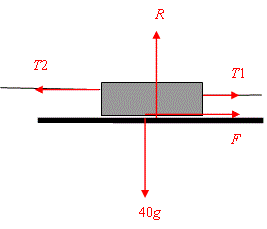Solution 3.11c
From Mechanics
(Difference between revisions)
(New page: Image:11c.gif) |
|||
| (One intermediate revision not shown.) | |||
| Line 1: | Line 1: | ||
| - | [[Image:11c.gif]] | + | Consider the equilibrium of the block. All the forces on the block must cancel out. |
| + | The following diargram shows all the forces on the block. | ||
| + | The frictional force must point to the right, (why?). | ||
| + | |||
| + | [[Image:3.11c.gif]] | ||
| + | |||
| + | Horisontally | ||
| + | |||
| + | <math>\begin{align} | ||
| + | & T2-T1-F=0 \\ | ||
| + | & F=T2-T1=245-19\textrm{.}6=225\textrm{.}4\ \text{N} \\ | ||
| + | \end{align}</math> | ||
| + | |||
| + | Vertically | ||
| + | |||
| + | <math>\begin{align} | ||
| + | & R-40g=0\ \text{giving} \\ | ||
| + | & R=392\ \text{N} \\ | ||
| + | \end{align}</math> | ||
| + | |||
| + | The friction condition gives | ||
| + | |||
| + | <math>\begin{align} | ||
| + | & 225\textrm{.}4\le \mu 392\ \text{or} \\ | ||
| + | & \mu \ge \frac{225\textrm{.}4}{392\ }=\frac{23}{40} \\ | ||
| + | & \\ | ||
| + | \end{align}</math> | ||
Current revision
Consider the equilibrium of the block. All the forces on the block must cancel out. The following diargram shows all the forces on the block. The frictional force must point to the right, (why?).
Horisontally
\displaystyle \begin{align} & T2-T1-F=0 \\ & F=T2-T1=245-19\textrm{.}6=225\textrm{.}4\ \text{N} \\ \end{align}
Vertically
\displaystyle \begin{align} & R-40g=0\ \text{giving} \\ & R=392\ \text{N} \\ \end{align}
The friction condition gives
\displaystyle \begin{align} & 225\textrm{.}4\le \mu 392\ \text{or} \\ & \mu \ge \frac{225\textrm{.}4}{392\ }=\frac{23}{40} \\ & \\ \end{align}

